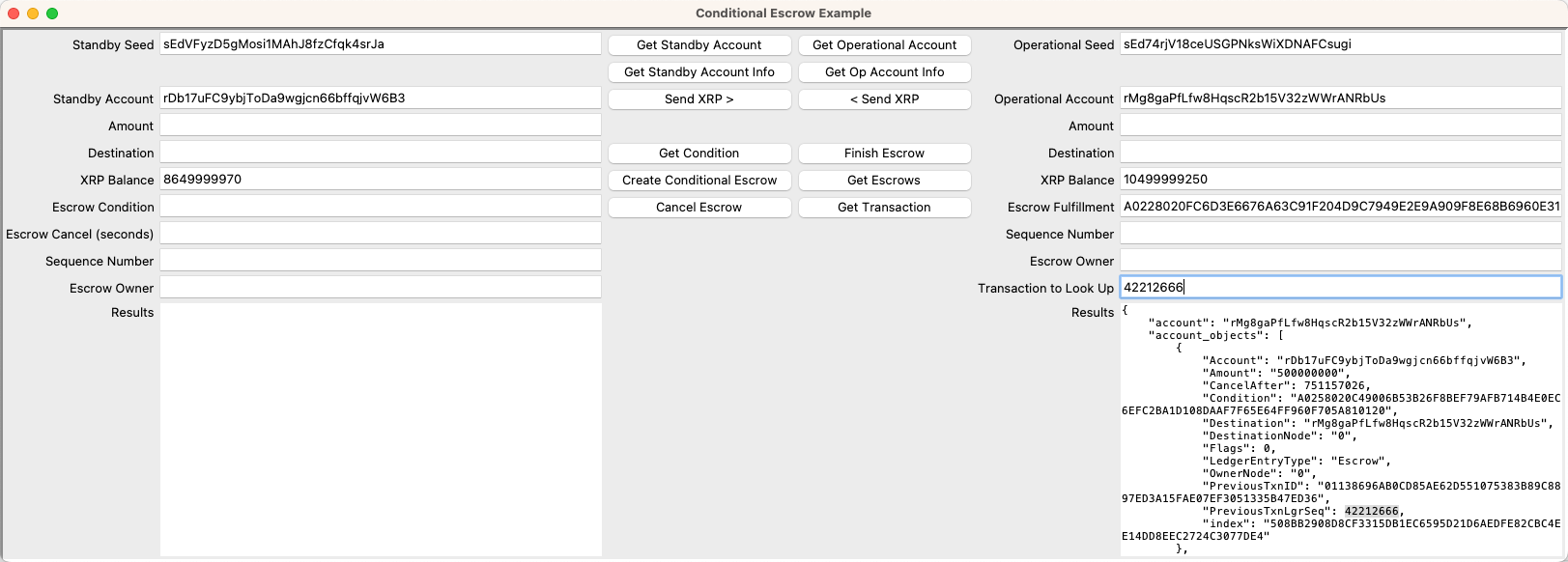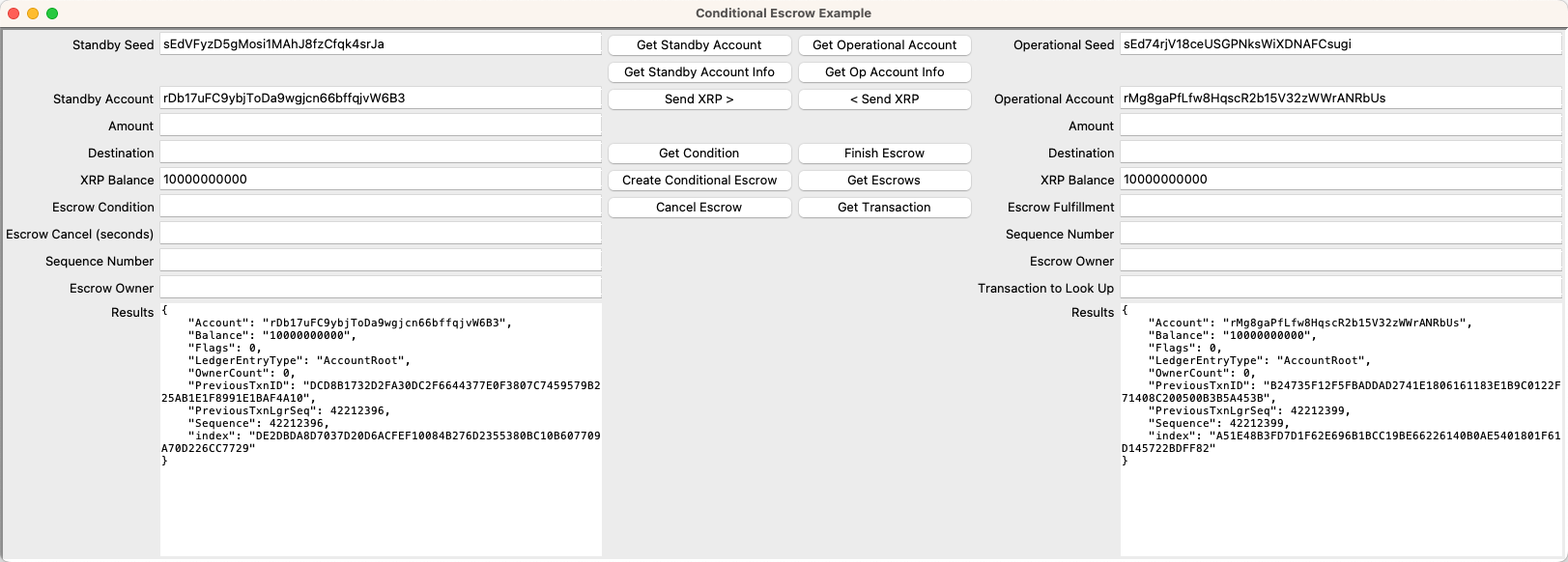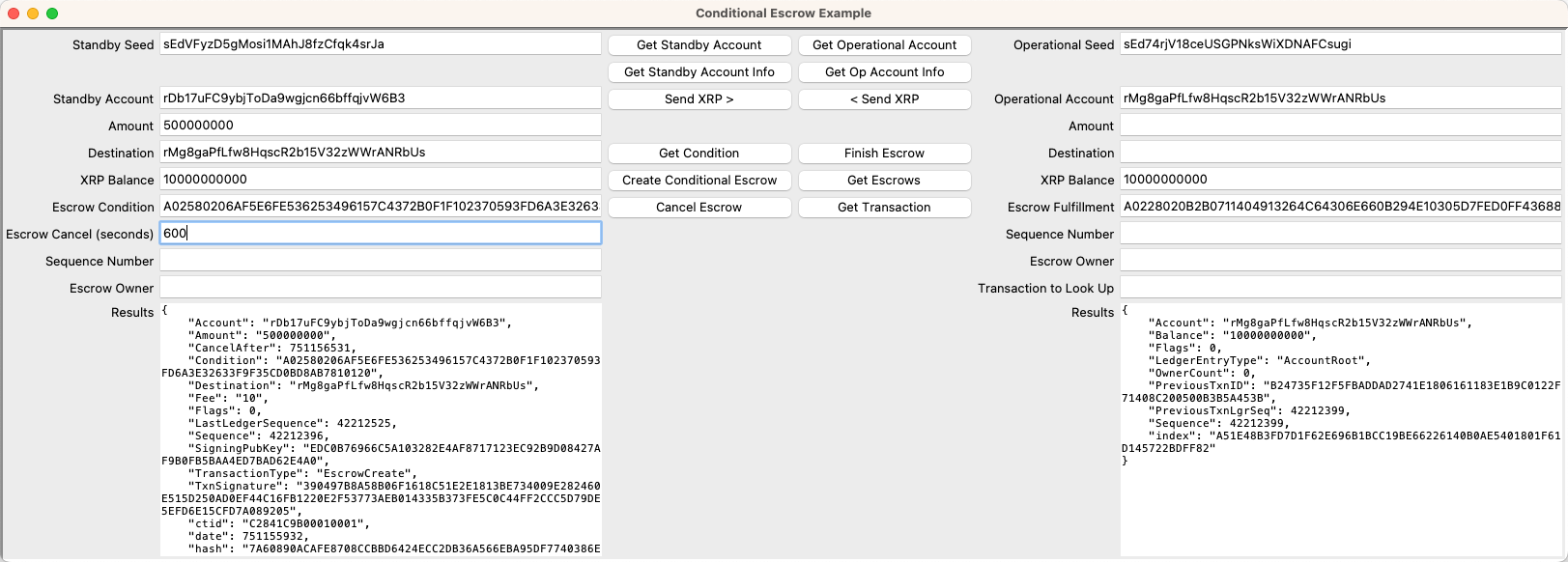This example shows how to:
Create escrow payments that become available when an account enters a fulfillment code.
Complete a conditional escrow transaction.
Cancel a conditional escrow transaction.
Download and expand the Quickstart Samples archive.
You need the cryptoconditions module to generate your condition/fulfillment pair. You can install the module using pip.
In a terminal window, install the cryptoconditions module with this command:
pip install cryptoconditionsTo get test accounts:
- Open and run
lesson9-conditional-escrow.py. - Get test accounts.
- If you have existing account seeds
- Paste Standby account seed in the Standby Seed field.
- Click Get Standby Account.
- Click Get Standby Account Info.
- Paste Operational account seed in the Operational Seed field.
- Click Get Operational Account.
- Click Get Op Account Info.
- If you do not have account seeds:
- Click Get Standby Account.
- Click Get Standby Account Info.
- Click Get Operational Account.
- Click Get Op Account Info.
- If you have existing account seeds
Click Get Condition to generate a condition/fulfillment pair and populate the fields on the form. You can copy the values and store them in a text file for safe keeping.
When you create a conditional escrow, you need to specify the Condition value you generated above. You must also set a cancel date and time, after which the escrow is no longer available.
To create a conditional escrow:
- Enter an Amount to transfer.
- Copy the Operational Account value.
- Paste it in the Destination Account field.
- Enter the Escrow Cancel (seconds) value.
- Click Create Escrow.
- Copy and save the Sequence Number of the escrow called out in the Standby Result field.
The escrow is created on the XRP Ledger instance, reserving your requested XRP amount plus the transaction cost.
When you create an escrow, capture and save the Sequence Number so that you can use it to finish the escrow transaction.
Any account can finish the conditional escrow any time before the Escrow Cancel time. Following on the example above, you can use the Sequence Number to finish the transaction once the Escrow Cancel time has passed.
To finish a conditional escrow:
- Paste the sequence number in the Operational account Sequence Number field.
- Enter the Escrow Condition value.
- Enter the Escrow Fulfillment code for the
Condition. - Copy the Standby Account value.
- Paste it into the Escrow Owner field.
- Click Finish Conditional Escrow.
The transaction completes and balances are updated for both the Standby and Operational accounts.
Click Get Escrows for either the Standby account or the Operational account to see their current list of escrows.
When the Escrow Cancel time passes, the escrow is no longer available to the recipient. The initiator of the escrow can reclaim the XRP, less the transaction fees. Any account can cancel an escrow once the cancel time has elapsed. Accounts that try to cancel the transaction prior to the Escrow Cancel time are charged the nominal transaction cost (about 10-15 drops), but the actual escrow cannot be cancelled until after the Escrow Cancel time.
If you forget to save the sequence number, you can find it in the escrow transaction record.
- Create a new escrow as described in Create Conditional Escrow, above.
- Click Get Escrows to get the escrow information.
- Copy the PreviousTxnLgrSeq value from the results.

- Paste the PreviousTxnLgrSeq in the Transaction to Look Up field.

- Click Get Transaction.
- Locate the Sequence value in the results.

You can download the Modular Tutorialsin the source repository for this website.
Import dependencies.
import xrpl
from xrpl.clients import JsonRpcClient
from xrpl.wallet import Wallet
from datetime import datetime
from xrpl.models.transactions import EscrowCreate, EscrowFinish
from os import urandom
from cryptoconditions import PreimageSha256Create a global variable pointing to Testnet.
testnet_url = "https://s.altnet.rippletest.net:51234"Generate the condition and fulfillment values for the escrow.
def generate_condition():Set a variable to 32 random bytes.
randy = urandom(32)Use the 32-byte random variable as the argument for the PreimageSha256 functino.
fulfillment = PreimageSha256(preimage=randy)Return the binary condition and the binary serialized (fulfillment) value.
return (fulfillment.condition_binary.hex().upper(),
fulfillment.serialize_binary().hex().upper())Create a date in the Ripple epoch, adding the specified number of seconds.
def add_seconds(numOfSeconds):Create a new_date variable.
new_date = datetime.now()Convert the date to a Ripple time object.
if new_date != '':
new_date = xrpl.utils.datetime_to_ripple_time(new_date)Add the requested seconds to the Ripple formatted date variable.
new_date = new_date + int(numOfSeconds)Return the result.
return new_dateYou create conditional escrows using the same EscrowCreate model you used for a time-based escrow, but instead of a finish time, you provide a condition that must be met to complete the transaction.
Pass the seed for the sending account, the amount to hold in escrow, the destination account to receive the escrow funds, the number of seconds until the escrow will cancel, and a condition value that will be matched with a fulfillment value to complete the escrow.
def create_conditional_escrow(seed, amount, destination, cancel, condition):Instantiate a wallet and connect to Testnet.
wallet=Wallet.from_seed(seed)
client=JsonRpcClient(testnet_url)Create a cancel_date variable, adding your specified number of seconds to the current Ripple epoch date.
cancel_date = add_seconds(cancel)Define the transaction with your provided values.
escrow_tx=xrpl.models.transactions.EscrowCreate(
account=wallet.address,
amount=amount,
destination=destination,
cancel_after=cancel_date,
condition=condition
) Submit the transaction and return the results.
reply=""
try:
response=xrpl.transaction.submit_and_wait(escrow_tx,client,wallet)
reply=response.result
except xrpl.transaction.XRPLReliableSubmissionException as e:
reply=f"Submit failed: {e}"
return replyAt any time prior to the cancel date, the destination account can fulfill the escrow.
Pass the seed for the receiving account, the owner (sending account), the sequence number for the escrow, the condition value, and the matching fulfillment value.
def finish_conditional_escrow(seed, owner, sequence, condition, fulfillment):Instantiate the account wallet and connect to Testnet.
wallet=Wallet.from_seed(seed)
client=JsonRpcClient(testnet_url)Define the EscrowFinish transaction, including both the condition and the fulfillment values.
finish_tx=xrpl.models.transactions.EscrowFinish(
account=wallet.address,
owner=owner,
offer_sequence=int(sequence),
condition=condition,
fulfillment=fulfillment
)Submit the transaction and report the results.
reply=""
try:
response=xrpl.transaction.submit_and_wait(finish_tx,client,wallet)
reply=response.result
except xrpl.transaction.XRPLReliableSubmissionException as e:
reply=f"Submit failed: {e}"
return replyThis example builds on lesson8-time-escrow.py to reuse fields, buttons, and functions that apply to both time-based and conditional escrows. Updates are highlighted below.
import tkinter as tk
import xrpl
import json
from mod1 import get_account, get_account_info, send_xrp
from mod8 import get_escrows, cancel_time_escrow, get_transactionImport new functions for conditional escrows from module 9.
from mod9 import create_conditional_escrow, finish_conditional_escrow, generate_condition
Add handlers for creating and finishing conditional escrows.
def get_condition():
results = generate_condition()
ent_standby_escrow_condition.delete(0, tk.END)
ent_standby_escrow_condition.insert(0, results[0])
ent_operational_escrow_fulfillment.delete(0, tk.END)
ent_operational_escrow_fulfillment.insert(0, results[1])
def standby_create_conditional_escrow():
results = create_conditional_escrow(
ent_standby_seed.get(),
ent_standby_amount.get(),
ent_standby_destination.get(),
ent_standby_escrow_cancel.get(),
ent_standby_escrow_condition.get()
)
text_standby_results.delete("1.0", tk.END)
text_standby_results.insert("1.0", json.dumps(results, indent=4))
def operational_finish_conditional_escrow():
results = finish_conditional_escrow(
ent_operational_seed.get(),
ent_operational_escrow_owner.get(),
ent_operational_sequence_number.get(),
ent_standby_escrow_condition.get(),
ent_operational_escrow_fulfillment.get()
)
text_operational_results.delete("1.0", tk.END)
text_operational_results.insert("1.0", json.dumps(results, indent=4))
## Mod 8 Handlers
def operational_get_escrows():
results = get_escrows(ent_operational_account.get())
text_operational_results.delete("1.0", tk.END)
text_operational_results.insert("1.0", json.dumps(results, indent=4))
def standby_cancel_time_escrow():
results = cancel_time_escrow(
ent_standby_seed.get(),
ent_standby_escrow_owner.get(),
ent_standby_escrow_sequence_number.get()
)
text_standby_results.delete("1.0", tk.END)
text_standby_results.insert("1.0", json.dumps(results, indent=4))
def operational_get_transaction():
results = get_transaction(ent_operational_account.get(),
ent_operational_look_up.get())
text_operational_results.delete("1.0", tk.END)
text_operational_results.insert("1.0", json.dumps(results, indent=4))
## Mod 1 Handlers
def get_standby_account():
new_wallet = get_account(ent_standby_seed.get())
ent_standby_account.delete(0, tk.END)
ent_standby_seed.delete(0, tk.END)
ent_standby_account.insert(0, new_wallet.classic_address)
ent_standby_seed.insert(0, new_wallet.seed)
def get_standby_account_info():
accountInfo = get_account_info(ent_standby_account.get())
ent_standby_balance.delete(0, tk.END)
ent_standby_balance.insert(0,accountInfo['Balance'])
text_standby_results.delete("1.0", tk.END)
text_standby_results.insert("1.0",json.dumps(accountInfo, indent=4))
def standby_send_xrp():
response = send_xrp(ent_standby_seed.get(),ent_standby_amount.get(),
ent_standby_destination.get())
text_standby_results.delete("1.0", tk.END)
text_standby_results.insert("1.0",json.dumps(response.result, indent=4))
get_standby_account_info()
get_operational_account_info()
def get_operational_account():
new_wallet = get_account(ent_operational_seed.get())
ent_operational_account.delete(0, tk.END)
ent_operational_account.insert(0, new_wallet.classic_address)
ent_operational_seed.delete(0, tk.END)
ent_operational_seed.insert(0, new_wallet.seed)
def get_operational_account_info():
accountInfo = get_account_info(ent_operational_account.get())
ent_operational_balance.delete(0, tk.END)
ent_operational_balance.insert(0,accountInfo['Balance'])
text_operational_results.delete("1.0", tk.END)
text_operational_results.insert("1.0",json.dumps(accountInfo, indent=4))
def operational_send_xrp():
response = send_xrp(ent_operational_seed.get(),ent_operational_amount.get(),
ent_operational_destination.get())
text_operational_results.delete("1.0", tk.END)
text_operational_results.insert("1.0",json.dumps(response.result,indent=4))
get_standby_account_info()
get_operational_account_info()Rename the window.
window = tk.Tk()
window.title("Conditional Escrow Example")
# Form frame
frm_form = tk.Frame(relief=tk.SUNKEN, borderwidth=3)
frm_form.pack()
# Create the Label and Entry widgets for "Standby Account"
lbl_standy_seed = tk.Label(master=frm_form, text="Standby Seed")
ent_standby_seed = tk.Entry(master=frm_form, width=50)
lbl_standby_account = tk.Label(master=frm_form, text="Standby Account")
ent_standby_account = tk.Entry(master=frm_form, width=50)
lbl_standy_amount = tk.Label(master=frm_form, text="Amount")
ent_standby_amount = tk.Entry(master=frm_form, width=50)
lbl_standby_destination = tk.Label(master=frm_form, text="Destination")
ent_standby_destination = tk.Entry(master=frm_form, width=50)
lbl_standby_balance = tk.Label(master=frm_form, text="XRP Balance")
ent_standby_balance = tk.Entry(master=frm_form, width=50)Add a field for the escrow condition.
lbl_standby_escrow_condition = tk.Label(master=frm_form, text="Escrow Condition")
ent_standby_escrow_condition = tk.Entry(master=frm_form, width=50)
lbl_standby_escrow_cancel = tk.Label(master=frm_form, text="Escrow Cancel (seconds)")
ent_standby_escrow_cancel = tk.Entry(master=frm_form, width=50)
lbl_standby_escrow_sequence_number = tk.Label(master=frm_form, text="Sequence Number")
ent_standby_escrow_sequence_number = tk.Entry(master=frm_form, width=50)
lbl_standby_escrow_owner = tk.Label(master=frm_form, text="Escrow Owner")
ent_standby_escrow_owner = tk.Entry(master=frm_form, width=50)
lbl_standby_results = tk.Label(master=frm_form, text="Results")
text_standby_results = tk.Text(master=frm_form, height = 20, width = 65)
# Place fields in a grid.
lbl_standy_seed.grid(row=0, column=0, sticky="e")
ent_standby_seed.grid(row=0, column=1)
lbl_standby_account.grid(row=2, column=0, sticky="e")
ent_standby_account.grid(row=2, column=1)
lbl_standy_amount.grid(row=3, column=0, sticky="e")
ent_standby_amount.grid(row=3, column=1)
lbl_standby_destination.grid(row=4, column=0, sticky="e")
ent_standby_destination.grid(row=4, column=1)
lbl_standby_balance.grid(row=5, column=0, sticky="e")
ent_standby_balance.grid(row=5, column=1)Insert the condition field in the standby grid.
lbl_standby_escrow_condition.grid(row=6, column=0, sticky="e")
ent_standby_escrow_condition.grid(row=6, column=1)
lbl_standby_escrow_cancel.grid(row=7, column=0, sticky="e")
ent_standby_escrow_cancel.grid(row=7, column=1)
lbl_standby_escrow_sequence_number.grid(row=8, column=0, sticky="e")
ent_standby_escrow_sequence_number.grid(row=8, column=1)
lbl_standby_escrow_owner.grid(row=9, column=0, sticky="e")
ent_standby_escrow_owner.grid(row=9, column=1)
lbl_standby_results.grid(row=10, column=0, sticky="ne")
text_standby_results.grid(row=10, column=1, sticky="nw")
###############################################
## Operational Account ########################
###############################################
# Create the Label and Entry widgets for "Operational Account"
lbl_operational_seed = tk.Label(master=frm_form, text="Operational Seed")
ent_operational_seed = tk.Entry(master=frm_form, width=50)
lbl_operational_account = tk.Label(master=frm_form, text="Operational Account")
ent_operational_account = tk.Entry(master=frm_form, width=50)
lbl_operational_amount = tk.Label(master=frm_form, text="Amount")
ent_operational_amount = tk.Entry(master=frm_form, width=50)
lbl_operational_destination = tk.Label(master=frm_form, text="Destination")
ent_operational_destination = tk.Entry(master=frm_form, width=50)
lbl_operational_balance = tk.Label(master=frm_form, text="XRP Balance")
ent_operational_balance = tk.Entry(master=frm_form, width=50)Add a field for the escrow fulfillment value.
lbl_operational_escrow_fulfillment = tk.Label(master=frm_form, text="Escrow Fulfillment")
ent_operational_escrow_fulfillment = tk.Entry(master=frm_form, width=50)
lbl_operational_sequence_number = tk.Label(master=frm_form, text="Sequence Number")
ent_operational_sequence_number = tk.Entry(master=frm_form, width=50)
lbl_operational_escrow_owner=tk.Label(master=frm_form, text="Escrow Owner")
ent_operational_escrow_owner=tk.Entry(master=frm_form, width=50)
lbl_operational_look_up = tk.Label(master=frm_form, text="Transaction to Look Up")
ent_operational_look_up = tk.Entry(master=frm_form, width=50)
lbl_operational_results = tk.Label(master=frm_form,text='Results')
text_operational_results = tk.Text(master=frm_form, height = 20, width = 65)
#Place the widgets in a grid
lbl_operational_seed.grid(row=0, column=4, sticky="e")
ent_operational_seed.grid(row=0, column=5, sticky="w")
lbl_operational_account.grid(row=2,column=4, sticky="e")
ent_operational_account.grid(row=2,column=5, sticky="w")
lbl_operational_amount.grid(row=3, column=4, sticky="e")
ent_operational_amount.grid(row=3, column=5, sticky="w")
lbl_operational_destination.grid(row=4, column=4, sticky="e")
ent_operational_destination.grid(row=4, column=5, sticky="w")
lbl_operational_balance.grid(row=5, column=4, sticky="e")
ent_operational_balance.grid(row=5, column=5, sticky="w")Insert the Fulfillment field in the operational grid, moving the other fields down so as to align the Condition and Fulfillment fields horizontally.
lbl_operational_escrow_fulfillment.grid(row=6, column=4, sticky="e")
ent_operational_escrow_fulfillment.grid(row=6, column=5, sticky="w")
lbl_operational_sequence_number.grid(row=7, column=4, sticky="e")
ent_operational_sequence_number.grid(row=7, column=5, sticky="w")
lbl_operational_escrow_owner.grid(row=8, column=4, sticky="e")
ent_operational_escrow_owner.grid(row=8, column=5, sticky="w")
lbl_operational_look_up.grid(row=9, column=4, sticky="e")
ent_operational_look_up.grid(row=9, column=5, sticky="w")
lbl_operational_results.grid(row=10, column=4, sticky="ne")
text_operational_results.grid(row=10, column=5, sticky="nw")
#############################################
## Buttons ##################################
#############################################
# Create the Get Standby Account Buttons
btn_get_standby_account = tk.Button(master=frm_form, text="Get Standby Account",
command = get_standby_account)
btn_get_standby_account.grid(row = 0, column = 2, sticky = "nsew")
btn_get_standby_account_info = tk.Button(master=frm_form,
text="Get Standby Account Info",
command = get_standby_account_info)
btn_get_standby_account_info.grid(row = 1, column = 2, sticky = "nsew")
btn_standby_send_xrp = tk.Button(master=frm_form, text="Send XRP >",
command = standby_send_xrp)
btn_standby_send_xrp.grid(row = 2, column = 2, sticky = "nsew")Add a Create Conditional Escrow button to the Standby grid.
btn_standby_get_condition = tk.Button(master=frm_form, text="Get Condition",
command = get_condition)
btn_standby_get_condition.grid(row=4, column=2, sticky="nsew")
btn_standby_create_escrow = tk.Button(master=frm_form, text="Create Conditional Escrow",
command = standby_create_conditional_escrow)
btn_standby_create_escrow.grid(row=5, column = 2, sticky="nsew")
btn_standby_cancel_escrow = tk.Button(master=frm_form, text="Cancel Escrow",
command = standby_cancel_time_escrow)
btn_standby_cancel_escrow.grid(row=6,column = 2, sticky="nsew")
# Create the Operational Account Buttons
btn_get_operational_account = tk.Button(master=frm_form,
text="Get Operational Account",
command = get_operational_account)
btn_get_operational_account.grid(row=0, column=3, sticky = "nsew")
btn_get_op_account_info = tk.Button(master=frm_form, text="Get Op Account Info",
command = get_operational_account_info)
btn_get_op_account_info.grid(row=1, column=3, sticky = "nsew")
btn_op_send_xrp = tk.Button(master=frm_form, text="< Send XRP",
command = operational_send_xrp)
btn_op_send_xrp.grid(row=2, column = 3, sticky = "nsew")Add a Finish Escrow button to the operational grid.
btn_op_finish_escrow = tk.Button(master=frm_form, text="Finish Escrow",
command = operational_finish_conditional_escrow)
btn_op_finish_escrow.grid(row = 4, column = 3, sticky="nsew")
btn_op_get_escrows = tk.Button(master=frm_form, text="Get Escrows",
command = operational_get_escrows)
btn_op_get_escrows.grid(row = 5, column = 3, sticky="nsew")
btn_op_get_transaction = tk.Button(master=frm_form, text="Get Transaction",
command = operational_get_transaction)
btn_op_get_transaction.grid(row = 6, column = 3, sticky = "nsew")
# Start the application
window.mainloop()



